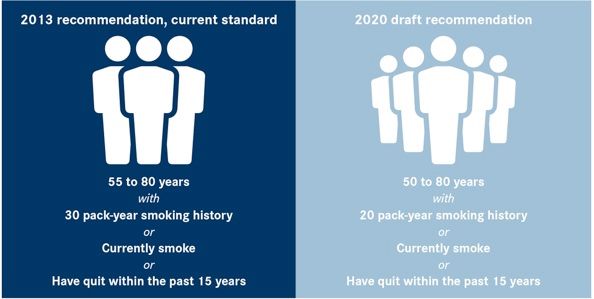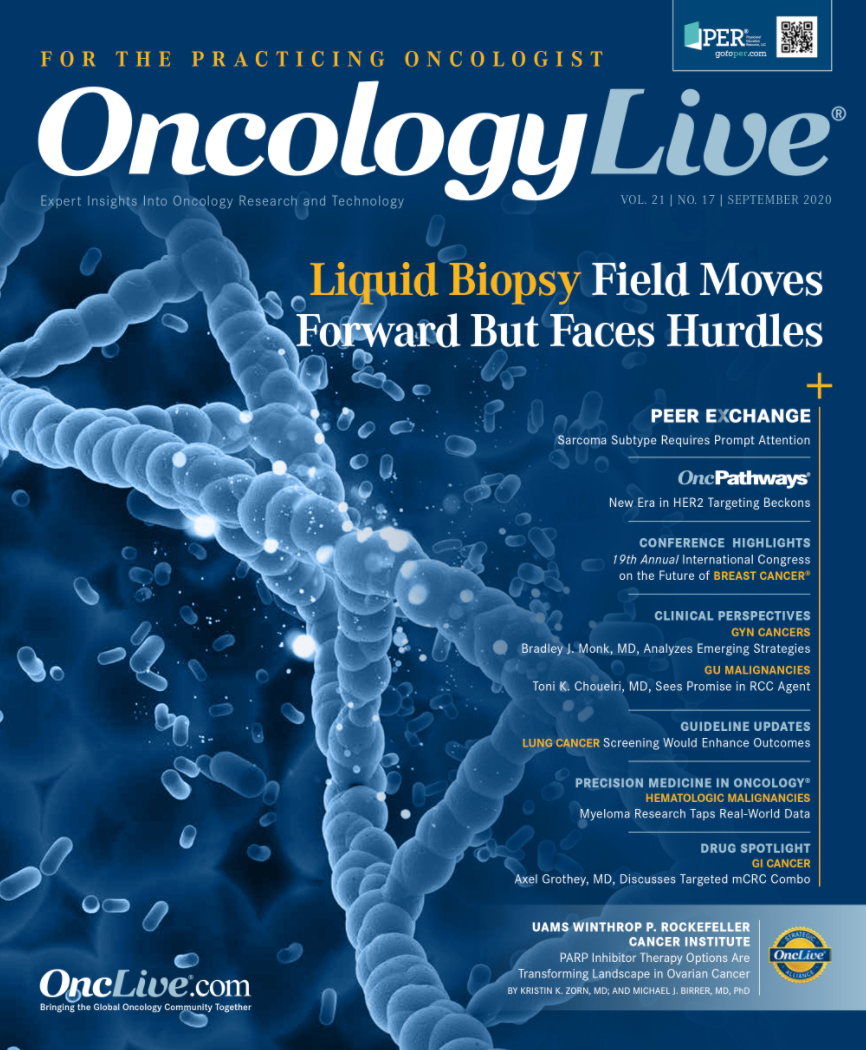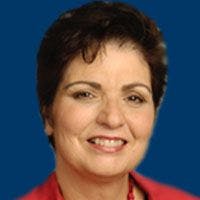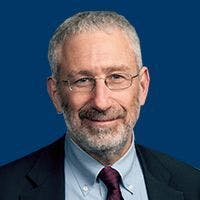Publication
Article
Oncology Live®
Expanded Lung Cancer Screening Criteria Would Boost Survival Outcomes
Author(s):
Under a draft recommendation proposed by the US Preventive Services Task Force, individuals who are at a high risk for developing lung cancer because of their smoking history would begin annual screening with low-dose computed tomography at aged 50 years.
Michael J. Barry, MD

Under a draft recommendation proposed by the US Preventive Services Task Force (USPSTF), individuals who are at a high risk for developing lung cancer because of their smoking history would begin annual screening with low-dose computed tomography (LDCT) at aged 50 years rather than the current clinical standard of aged 55 years.1,2
The draft guidance would update the USPSTF’s 2013 recommendation that adults aged 55 to 80 years who have a 30 pack-year smoking history, currently smoke, or have quit within the past 15 years pursue yearly screening with LDCT.2 By expanding not only the eligibility criteria for preventive screening but also the risk threshold, the draft guidance is expected to significantly increase the number of individuals who are candidates for screening, translating to earlier diagnosis and intervention and lower mortality.1
Specifically, the newly proposed recommendation would support annual screening with LDCT in adults aged 50 to 80 years who have a 20 pack-year smoking history, currently smoke, or have quit within the past 15 years (FIGURE).1,2 The 10-year reduction in packyear will make LDCT-based screening more broadly accessible to women and African Americans in particular, who typically smoke less than white men and consequently are not qualified for preventive screening under the prior 30 pack-year guideline, explained USPSTF member, Michael J. Barry, MD.
"We looked at the CISNET [Cancer Intervention and Surveillance Modeling Network] network of decision models funded by the National Cancer Institute and at the implications for different starting ages and pack-year criteria. The modeling supported evidence from clinical trials that we could save more lives by expanding the criteria and bringing in more women and African Americans,” said Barry, president of the Informed Medical Decisions Program in the Health Decision Sciences Center and medical director of the John D. Stoeckle Center for Primary Care Innovation both at Massachusetts General Hospital and professor of medicine at Harvard Medical School, in Boston. African American race is a known risk factor for lung cancer, along with chronic obstructive pulmonary disease, prior radiation therapy, family history, and occupational exposure.1 “African Americans seem to be at a higher risk for lung cancer for any given number of pack-years than white people,” Barry said.
Past studies have observed that some individuals who do not meet the existing age or pack-year USPSTF criteria for screening could nevertheless benefit from it.1 The more inclusive recommendation put forth by the task force is meant to extend screening to a broader number of people for whom annual assessment might be advantageous, Barry said.
Although the USPSTF is moving to broaden the age and risk threshold, it will continue to support screening discontinuation once a person has either “not smoked for 15 years or develops a health problem that substantially limits life expectancy or the ability for curative lung surgery” in its newly proposed update.1 The draft guidance is classified as a grade B recommendation, indicating there is “high certainty that the net benefit is moderate or there is moderate certainty that the net benefit is moderate to substantial,” justifying implementation of the given intervention.3
FIGURE. LDCT Screening Criteria: 2013 Versus 2020

New Data Support Expanded Criteria
The task force reviewed 223 publications and 7 randomized controlled trials (RCTs) between May 28, 2019, and March 2020 to evaluate existing evidence on the efficacy of LDCT in the United States. LDCT, which is the only recommended screening test for lung cancer, uses a low dose of radiation during CT to take diagnostic images of a patient’s lungs.1
In a risk-benefit analysis of broader LDCT screening, the USPSTF identified false-positive results that could lead to unnecessary testing, invasive procedures, and radiation-induced cancer, albeit rare, as potential harms of LDCT. For example, of every 1000 individuals screened in the National Lung Screening Trial (NLST), false-positive results prompted 17 invasive procedures. However, the USPSTF maintains that the benefits of LDCT outweigh its detriments. In its review of findings from several RCTs, the task force observed a reduction in lung cancer mortality with the use of LDCT. In the phase 3 NLST trial (NCT00047385), which enrolled 53,454 patients, 3 rounds of annual LDCT screening lowered both lung cancer mortality (IRR, 0.85; 95% CI, 0.75-0.96) and all-cause mortality compared with chest x-rays. The NLST population comprised high-risk current and former smokers aged 55 to 74 years. The number needed to screen to prevent 1 lung cancer death over 6.5 years of follow-up was 323, investigators said.1
Findings from the Nederlands-Leuvens Longkanker Screenings Onderzoek (NELSON) study (ISRCTN63545820) corroborated the benefit of LDCT, demonstrating a decrease in lung cancer mortality with 4 rounds of screening with increasing intervals: baseline, 1 year, 3 years, and 5.5 years. The drop in lung cancer mortality seen in its population of 15,792 high-risk patients who were current or former smokers aged 50 to 74 years (IRR, 0.75; 95% CI, 0.61-0.90) was not accompanied by a decline in all-cause mortality, unlike NLST (IRR, 1.01; 95% CI, 0.92-1.11). These data from NELSON translated to a number needed to screen of 130 to prevent 1 lung cancer death over 10 years of follow-up.1
The USPSTF’s rationale for proposing an update to its existing recommendation is based in large part on new clinical evidence of the preventive utility of LDCT. “The previous recommendation was based pretty squarely on NLST. Now, hot off the presses, we have data from the NELSON trial, which enrolled people down to age 50. In fact, about a quarter of the participants were under age 55 and would not have been included in NLST,” Barry said, adding that NELSON also included lighter smokers with an average pack-year of 38 versus 56 in NLST. “Despite including younger people and lighter smokers, like NLST, NELSON showed a statistically significant benefit from screening,” he said.
Notably, NLST and NELSON were the only 2 RCTs of the 7 RCTs that the task force evaluated during its literature review period that were adequately powered.1
Despite Benefit, LDCT Uptake Is Lacking
Despite evidence of LDCT’s efficacy, USPSTF’s support of the preventive modality for the past 7 years, and insurance coverage, LDCT remains “heavily underutilized.” Research from Pham et al demonstrated that in 2016, 2% of the 7.6 million smokers eligible for LDCT were screened. Investigators observed a variation in screening rates by region, ranging from 1.1% in the West to 3.9% in the Northeast. The South accounted for 40.4% of eligible smokers, and although it housed the most accredited screening sites of all regions (37%), it had among the lowest screening rate in the nation, at 1.7%.4
Barry said the USPSTF is not only aware of LDCT’s underutilization but has also called for additional investigations into the optimal implementation of the screening technique, particularly in “vulnerable” and high-risk patient populations, such as African Americans. Nevertheless, the reasons for LDCT’s slow uptake are not wholly apparent at present. “We don’t fully understand the reasons, but clearly part of it is that even though we made our prior recommendation in 2013, lung cancer screening is a relatively new kid on the block compared with pap smears for cervical cancer screening or mammograms for breast cancer screening, so it’s going to take some time and attention before it becomes more widely used,” Barry said. “We’re hoping the implementation rates will increase, but there’s a lot of work to be done in that regard.”
Lung cancer is currently the leading cause of cancer-related death in both men and women in the United States,1 with an estimated 228,820 new cases and 135,720 deaths expected in 2020.5 Although the 5-year survival rates have increased from approximately 16% between 1995 and 2001 to 18.6% between 2008 and 2014 for all stages of disease, prognoses associated with this malignancy continue to be poor. By expanding the age and pack-year criteria for screening, the USPSTF hopes to drive LDCT uptake and diagnose lung cancer at an earlier stage in individuals at risk for developing it. The USPSTF’s draft recommendation remains under review after closing to public comment on August 3, 2020.
References
- Jonas DE, Reuland DS, Reddy SM, et al. Screening for lung cancer with low-dose computed tomography: an evidence review for the US Preventive Services Task Force. US Preventative Services Taskforce. July 7, 2020. Accessed July 23, 2020. https://www.uspreventiveservicestaskforce.org/uspstf/document/draft-evidence-review/lung-cancer-screening-2020
- Final recommendation statement; lung cancer: screening. US Preventive Services Task Force. December 31, 2013. Accessed July 14, 2020. https://www.uspreventiveservicestaskforce.org/uspstf/recommendation/lung-cancer-screening#full-recommendationstart
- Grade definitions. US Preventive Services Task Force. Updated June 2018. Accessed July 15, 2020. https://www.uspreventiveservicestaskforce.org/uspstf/grade-definitions
- Pham D, Bhandari S, Pinkston C, Oechsli M, Kloecker G. Lung cancer screening registry reveals low-dose CT screening remains heavily underutilized. Clin Lung Cancer. 2020;21(3):e206-e211. doi:10.1016/j.cllc.2019.09.002
- How common is lung cancer? American Cancer Society. Updated January 8, 2020. Accessed July 21, 2020. https://www.cancer.org/cancer/lung-cancer/about/key-statistics.html



























%20(2)%201-Recovered-Recovered-Recovered-Recovered-Recovered-Recovered-Recovered-Recovered-Recovered-Recovered-Recovered-Recovered-Recovered-Recovered-Recovered-Recovered-Recovered.jpg?fit=crop&auto=format)
%20(2)%201-Recovered-Recovered-Recovered-Recovered-Recovered-Recovered-Recovered-Recovered-Recovered-Recovered-Recovered-Recovered-Recovered-Recovered-Recovered-Recovered-Recovered.jpg?fit=crop&auto=format)
